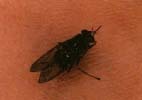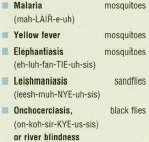Trypanosomiasis
Trypanosomiasis (trih-pan-o-so-MY-uh-sis) is a disease found in Africa and the American continents that is caused by infection with a parasite. Forms of the disease may persist for many years and have several phases, with symptoms that can vary from one stage to the next.
KEYWORDS
for searching the Internet and other reference sources
Chagas disease
Chagoma
Protozoa
Reduviid bug
Sleeping sickness
Trypanosoma brucei
Trypanosoma cruzi
Tsetse fly
What Is Trypanosomiasis?
Trypanosomiasis refers to three types of infections caused by protozoa * and spread to humans through insect bites. There are two kinds of African trypanosomiasis, East African and West African. Both of these varieties also are known as sleeping sickness. The disease can affect people living on the African continent south of the Sahara Desert. American trypanosomiasis also is called Chagas (SHAH-gus) disease. It occurs only on the American continents, from Mexico to Argentina.
What Causes Trypanosomiasis?
The bite of an infected tsetse (SET-see) fly usually transmits the organisms that cause the African forms of trypanosomiasis. These flies live in the countryside in Africa, especially in bushes and thick vegetation near rivers and lakes. Tsetse flies infected with the protozoan Trypanosoma brucei rhodesiense (trih-pan-o-SO-mah BRU-see-eye ro-dee-see-EN-see) spread East African trypanosomiasis, the most severe form of the disease, to humans. The West African variety comes from a fly infected with Trypanosoma brucei gambiense (trih-pan-o-SO-mah BRU-see-eye gam-be-EN-see).
* protozoa (pro-tuh-ZOH-uh) are single-celled microorganisms (tiny organisms), some of which are capable of causing disease in humans.
* feces (FEE-seez) is the excreted waste from the gastrointestinal tract.
Reduviid (rih-DO-vee-id) bugs (also called assassin, cone-nose, or kissing bugs) carry the Trypanosoma cruzi (trih-pan-o-SO-mah KROO-zee) protozoa that cause the American variety of trypanosomiasis, or Chagas disease, named for the Brazilian doctor who discovered it. These bugs hide during the day in the cracks in mud and adobe homes. At night they crawl across sleeping people and bite them, usually on the face but sometimes on the arms, legs, or trunk. They also leave behind their feces * , which contain the protozoa. Without knowing it, people can rub

How Common Is Trypanosomiasis?
Trypanosomiasis can infect people of every age and race, though it is uncommon in the United States. Since the late 1960s, fewer than 30 cases have been reported among U.S. citizens traveling to areas where the infection is found. In other parts of the world, however, the disease affects thousands of people. The World Health Organization estimates that as many as 500,000 people could have African trypanosomiasis, but because of poor monitoring most of these cases are not reported. Between 16 million and 18 million people in the Americas currently have Chagas disease. Approximately 50,000 may die from the disease each year.
Is Trypanosomiasis Contagious?
People cannot catch any form of trypanosomiasis in the same way that they catch a cold or the flu from other people. Only the tsetse fly spreads the African varieties, and the reduviid bug spreads Chagas disease. Rarely, a mother infected with the West African variety of trypanosomiasis or with Chagas disease can pass the illness to her unborn child. People who receive a transfusion * of blood or an organ transplant from an infected person also may contract the disease; this form of transmission tends to happen more often with Chagas disease than with the African types.
What Are the Symptoms of the Disease?
African trypanosomiasis
People who contract the African varieties of trypanosomiasis may start sleeping more, though this usually does not happen until the later stages of the disease. Sleeping sickness may start with the appearance of a sore called a chancre (SHANG-ker) at the spot where the person received the tsetse fly bite. Later symptoms include fever, extreme tiredness, severe headaches, rashes, itching, joint pain, and swelling of the hands and feet. The lymph nodes * on the back of the neck may become swollen as well. These signs typically appear 2 to 4 weeks after infection with East African trypanosomiasis.
* transfusion (trans-FYOO-zhun) is a procedure in which blood or certain parts of blood, such as specific cells, is given to a person who needs it because of illness or blood loss.
* lymph (LIMF) nodes are small, bean-shaped masses of tissue that contain immune system cells that fight harmful microorganisms. Lymph nodes may swell during infections.
* blood-brain barrier is a biological shield in the body that helps prevent germs or other potentially harmful materials in the blood from entering the brain and spinal cord.
* seizures (SEE-zhurs) are sudden bursts of disorganized electrical activity that interrupt the normal functioning of the brain, often leading to uncontrolled movements in the body and sometimes a temporary change in consciousness,
* chronic (KRAH-nik) means continuing for a long period of time.
* antibodies (AN-tih-bah-deez) are protein molecules produced by the body's immune system to help fight specific infections caused by microorganisms, such as bacteria and viruses.
Other symptoms can follow quickly, as the protozoa cross the blood-brain barrier * and start affecting a patient's mental functions. The later stages of sleeping sickness may bring mental confusion, changes in personality, problems with walking and talking, weight loss, and seizures * . The spleen and liver may become enlarged. Sleeping sickness gets its name from the later part of the disease, when the sick person has nighttime insomnia (in-SOM-nee-uh, an inability to sleep) but sleeps for long periods during the day. If the person does not receive treatment, the heart muscles may become inflamed or weakened, causing death from heart failure.
The early symptoms in West African trypanosomiasis are similar but may take longer to appear. Months or years may pass before an infected person becomes sick, and the disease develops more slowly, though it still can cause death if it is left untreated. The gap between infection and the start of symptoms can make this form of sleeping sickness difficult to diagnose.
Chagas disease
The first sign of Chagas disease may show up a few hours after infection, when a raised red spot called a chagoma (chuh-GO-mah) appears at the site of the insect bite. Most people have no other symptoms during the early, or acute, phase of the disease, which begins a few weeks later. People who experience symptoms may have fevers, rashes, extreme tiredness, vomiting, loss of appetite, or swollen lymph nodes. The side of the face where the infected feces were rubbed into an eye or a bug bite may swell. In most people these symptoms usually disappear within 4 to 8 weeks without causing problems, but infants can die in this early stage from brain swelling. About 10 to 20 years after this first phase, approximately one-third of infected people can show symptoms of the chronic * phase of Chagas disease. They may become constipated and experience trouble swallowing. The heart may become enlarged, and patients may have altered heart rhythms or heart failure leading to death.
How Do Doctors Diagnose Trypanosomiasis?
Because all types of trypanosomiasis are rare in the United States, it is important for people who have any symptoms of the disease to let their doctor know right away if they have been traveling in areas where the disease is common. To diagnose sleeping sickness or Chagas disease, a doctor will order blood tests to look for protozoa or antibodies * to the organism. In cases where the doctor suspects sleeping sickness, a sample drawn from fluid surrounding the brain and spinal cord or tissue from swollen lymph nodes may be examined for evidence of the disease. If a patient has a suspicious-looking skin lesion * , a biopsy * will be performed to test for Trypanosoma cruzi protozoa.
Can Trypanosomiasis Be Treated Successfully?
There are medications available to treat all types of the disease. Doctors recommend that people with trypanosomiasis receive treatment as soon as possible. Treatment is given in a hospital. After leaving the hospital, patients typically are watched closely by a doctor for at least 2 years, to see whether they show any signs that they still have the infection.
Global Warming
The bite of an insect can transmit bacteria, protozoa, or even worms into a person's bloodstream, leading to a variety of illnesses. Trypanosomiasis is just one example of a tropical insect-borne disease. Here are a few others, along with the insects that spread them:

|
■
Malaria
(mah-LAIR-e-uh) |
mosquitoes |
| ■ Yellow fever | mosquitoes |
|
■
Elephantiasis
(eh-luh-fan-TIE-uh-sis) |
mosquitoes |
|
■
Leishmaniasis
(leesh-muh-NYE-uh-sis) |
sandflies |
|
■
Onchocerciasis,
(on-koh-sir-KYE-us-sis) or river blindness |
black flies |
Why are these diseases common to the tropics? It is because the hot and often rainy climate makes the tropics an ideal breeding ground for insects. Greenpeace, among other organizations dedicated to protecting the environment, has warned that global warming could create new breeding grounds for insects throughout the world. At the same time, rising temperatures could raise insect reproductive rates, increasing their numbers. As the climate in the United States and Europe becomes more "tropical," diseases such as yellow fever and malaria may become more common, bringing the tropics into our own backyards.
* lesion (LEE-zhun) is a general term referring to a sore or a damaged or irregular area of tissue.
* biopsy (BI-op-see) is a test in which a small sample of skin or other body tissue is removed and examined for signs of disease.
What Happens to People with Trypanosomiasis?
East African sleeping sickness can move through the body quickly, progressing in just weeks or months to the most serious phase of illness. West African sleeping sickness takes longer to develop. People may not

Can Trypanosomiasis Be Prevented?
There is no vaccine or medication that can prevent any form of the disease, so it is wise for people who travel in areas where the disease is common to take precautions. In Africa this includes wearing clothes of thick material, with long sleeves and long pants. Neutral colors, such as tan, are best because tsetse flies are attracted to dark and bright colors. Doctors recommend that travelers to Africa sleep under netting and avoid riding in the backs of open trucks, because dust from moving vehicles attracts the flies. It is also advisable to not walk through brush. In areas where Chagas disease is found, it is a good idea for people to avoid sleeping in mud, adobe, or thatch houses; to sleep under netting; and to use insect repellent.
See also
Leishmaniasis
Travel-related Infections
Resources
Organizations
U.S. Centers for Disease Control and Prevention (CDC), 1600 Clifton
Road, Atlanta, GA 30333. The CDC publishes fact sheets on all three
types of trypanosomiasis at its website.
Telephone 800-311-3435
http://www.cdc.gov
World Health Organization (WHO), Avenue Appia 20, 1211 Geneva 27,
Switzerland. WHO publishes information on sleeping sickness and Chagas
disease at its website.
Telephone 011-41-22-791-2111
http://www.who.int
Comment about this article, ask questions, or add new information about this topic: